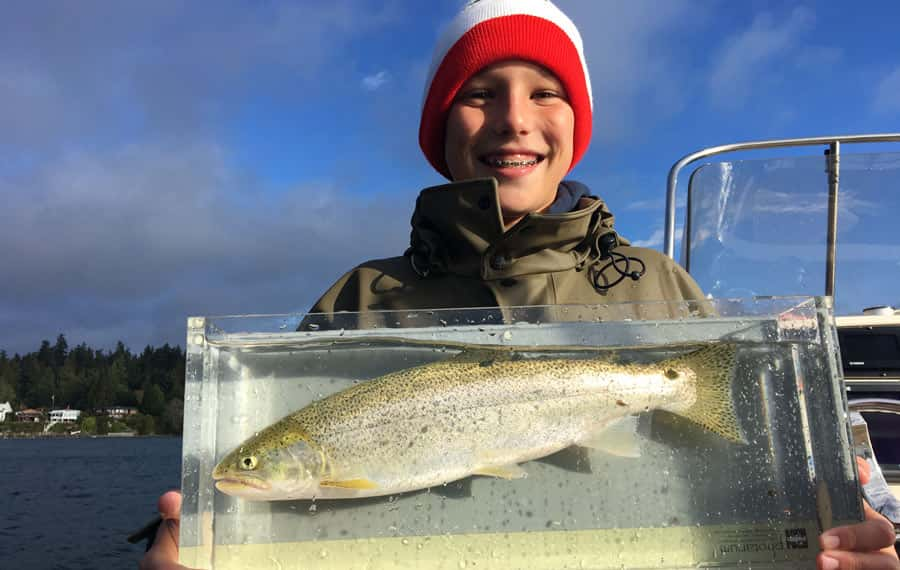BEGINNER’S GUIDE TO SALTWATER FLY FISHING
Date: April 9, 2021

When most people imagine fly fishing, they probably picture a person in waders in a river or stream, placidly flicking their line back and forth. However, fly fishing isn’t limited to moving bodies of fresh water; many have already discovered the joys of saltwater fly fishing. It is similar to freshwater fly fishing, but the prey can be bigger and the result more rewarding.
What Is Fly Fishing?
Fly fishing is different than standard fishing because of the amount of motion it involves. Typically, when people are fishing, they cast their line once in a while and then let it sit, hoping their lure, whether a synthetic lure or a worm, insect, or small fish, will attract a large fish with an appetite. In fly fishing, a synthetic lure, called a fly, is cast far from the fisher and then allowed to float, sink, or be slowly drawn back in toward the fisher, depending on the water type, fish type, and style preferred by the individual fishing. It can be more physical than traditional fishing, but also very rewarding.
Fly Fishing Requires Certain Gear
A standard fishing pole with a rigid back and covered reel generally won’t work for fly fishing, though those who are experts at the fly fishing process may be able to adapt their skills to this kind of equipment. What fly fishers need is a fly rod. These come in various weights and strengths, depending on the kind of fish you’re after. Generally, unless you’re after trophy fish, a 9-weight rod will be strong enough to reel in what you’re out there catching. You also need a higher-quality reel.
Should You Buy a Full Flex or Tip Stiff Rod?
You’ll need to decide what kind of rod to purchase: one that is stiffer or one that has more flexibility. Most of the time, those learning to fly fish start out with a full flex rod, as tip stiff rods can require more finesse than the average beginner possess. The trade off is that stiff tip rods can help ensure better casting when working with a heavier lure or a long cast. Full flex rods are generally preferable for lighter lines and shorter casts. If you have a friend or family member who fly fishes, you may want to try each style before you commit to one or the other via a purchase.
The Importance of the Reel
The reel helps you bring the lure back in, and its strength is critical to actually landing a fish once you’ve gotten them to bite. There are center drag reels and offset drags. The center drags offer somewhat better performance, but they come at a much higher price tag. Offset drag reels don’t have quite as much power as the center drag version, so you may have to manually slow the feed when fighting a big fish. At the end of the day, what matters most is that the reel matches and fits your rod and you feel comfortable handling it while you’re out on the water.
How to Save on Fly Fishing Equipment
Rods, reels, and the various accessories for fly fishing can quickly become prohibitively expensive. There’s a lot of up front investment to get started in fly fishing, a fact which can turn a lot of potential fly fishers off to the whole concept. A great way to save money on your rod and reel are to check local and big box fishing and sporting goods stores for clearance and end of season deals. If that doesn’t yield the results you need, consider searching on eBay. With diligence, a fly fisher can find quality used reels and rods at a reasonable price (just watch out for shipping). There’s also Craigslist for local resale possibilities.
Tying or Buying Your Lures?
Unless you learned how to tie a lure from a family member or friend with a skill for it, chances are that beginners will fare better by purchasing your fly or lure at first. There are a number of options, in terms of color, shape, and weight that must be considered. Spend some time looking up what more experienced fly fisher recommend for attracting the fish you’re going out after. While you’re at it, don’t forget to invest in high-quality line with high strength rating. You want a line that can endure fifteen to twenty pounds of pressure to ensure you can land even the biggest of fish.
Practice Your Casting!
The importance of practicing your casting can’t be overstated. The way you cast, and the power behind it, can make all the difference in the world when it comes to successfully tempting those fish to bite. Work with an experienced family member or friend to learn the motion, or consider hiring a professional who can offer you instruction in form and finesse. As a last resort, there are plenty of beginner’s DVDs available, and even instructional videos on YouTube that can help you get the hang of it! Stick with it for a day or two, and you should be ready to hit the water!
Featured photo source: Pixabay.com
